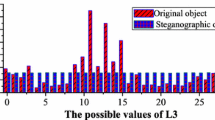Abstract
Steganalysis with low embedding rates is still a challenge in the field of information hiding. Speech signals are typically processed by wavelet packet decomposition, which is capable of depicting the details of signals with high accuracy. A steganography detection algorithm based on the Markov bidirectional transition matrix (MBTM) of the wavelet packet coefficient (WPC) of the second-order derivative-based speech signal is proposed. On basis of the MBTM feature, which can better express the correlation of WPC, a Support Vector Machine (SVM) classifier is trained by a large number of Least Significant Bit (LSB) hidden data with embedding rates of 1%, 3%, 5%, 8%,10%, 30%, 50%, and 80%. LSB matching steganalysis of speech signals with low embedding rates is achieved. The experimental results show that the proposed method has obvious superiorities in steganalysis with low embedding rates compared with the classic method using histogram moment features in the frequency domain (HMIFD) of the second-order derivative-based WPC and the second-order derivative-based Mel-frequency cepstral coefficients (MFCC). Especially when the embedding rate is only 3%, the accuracy rate improves by 17.8%, reaching 68.5%, in comparison with the method using HMIFD features of the second derivative WPC. The detection accuracy improves as the embedding rate increases.








Similar content being viewed by others
References
Chen B, Shu H, Coatrieux G, Chen G, Sun X, Coatrieux J-L (2015) Color image analysis by quaternion-type moments. J Math Imaging Vis 51(1):124–144
Cho S, Cha BH, Wang J, Kuo CCJ (2010) Block-based image steganalysis: Algorithm and performance evaluation. Proceedings of 2010 IEEE International Symposium on Circuits and Systems, Paris, 2010, pp 1679–1682
Fridrich J, Kodovský J (2012) Rich models for steganalysis of digital images. IEEE Trans Inf Forensics Secur 7(3):868–882
Gang X, Xijian P, Tao Z, Kan L (2013) Steganalysis of LSB Matching Based on the Measurement or the Region Randomness. J Comp Res Dev 50(5):942–950
Gu B, Sheng VS, Wang Z, Ho D, Osman S, Li S (2015) Incremental learning for ν-Support Vector Regression. Neural Netw 67:140–150
Guo H, Yan D, Wang R, Wang Z, Wang L, Linqiang TU (2015) MP3 steganalysis based on difference statistics. Comput Eng Appl 51(7):88–92
He Z, Lu W, Sun W et al (2012) Digital image splicing detection based on Markov features in DCT and DWT domain. Pattern Recogn 45(12):4292–4299
Huang Y, Tang S (2016) Covert voice over internet protocol communications based on spatial model. SCIENCE CHINA Technol Sci 59(1):117–128
Huang Y, Liu C, Tang S (2012) Steganography Integration into a Low-Bit Rate Speech Codec. IEEE Trans Inf Forensics Secur 7(6):1865–1875
Huang Y, Tang S, Yuan J (2011) Steganography in Inactive Frames of VoIP Streams Encoded by Source Codec. IEEE Trans Inf Forensics Secur 6(2):296–306
Huang YF, Tang S, Zhang Y (2011) Detection of covert voice-over Internet protocol communications using sliding window-based steganalysis. IET Commun 5(7):929–936
Huang Y, Tang S, Bao C, Yip YJ (2011) Steganalysis of compressed speech to detect covert voice over Internet protocol channels. IET Inf Secur 5(1):26–32
Kodovský J, Fridrich J (2012) Steganalysis of JPEG images using rich models. Proceedings Volume 8303, Media Watermarking, Security, and Forensics 2012, IS&T/SPIE Electronic Imaging, Burlingame, California, United States, 22 January 2012, pp 1–13
Li S, Tao H, Huang Y (2012) Detection of QIM steganography in G.723.1 bit stream based on quantization index sequence analysis. J Zhejiang Univ-Sci C (Comput Electron) 13(8):624–634
Li X, Zhang W, Gui X, Yang B (2013) A novel reversible data hiding scheme based on two-dimensional difference-histogram modification. IEEE Trans Inf Forensics Secur 8(7):1091–1100
Li X, Zhang W, Gui X (2015) Efficient reversible data hiding based on multiple histograms modification. IEEE Trans Inf Forensics Secur 10(9):2016–2027
Liu Q, Sung AH, Qiao M (2011) Derivative-based audio steganalysis. ACM Trans Multimedia Comput Commun 7(3, Article No. 18):1–18
Pevný T, Fridrich J (2007) Merging Markov and DCT features for multi-class JPEG steganalysis. Proceedings of Electronic Imaging, Security, Steganography, and Watermarking of Multimedia Contents, San Jose, CA. January 28, 2007, pp 1–13
Qin C, Hu YC (2016) Reversible data hiding in VQ index table with lossless coding and adaptive switching mechanism. Signal Process 129:48–55
Qin C, Chang C-C, Huang Y-H (2013) An inpainting-assisted reversible steganographic scheme using a histogram shifting mechanism. IEEE Trans Circ Syst Video Technol 23(7):1109–1118
Tang W, Li H, Luo W, Huang J (2016) Adaptive Steganalysis Based on Embedding Probabilities of Pixels. IEEE Trans Inf Forensics Secur 11(4):734–745
Tao Z, Yan Z, Wenxiang L et al (2009) Steganalysis of LSB matching exploiting correlations between pixel differences. J Comp Res Dev 46(Suppl):143–146 (in Chinese)
Tao H, Sun D, Huang Y, Hu P (2014) A detection method of subliminal channel based on VoIP communication. Proceedings of the 1st international workshop on Information hiding and its criteria for evaluation. Kyoto, Japan, June 03, 2014, pp 37–41
Xia Z, Wang X, Sun X, Wang B (2014) Steganalysis of least significant bit matching using multi-order differences. Secur Commun Netw 7(8):1283–1291
Xia Z, Wang X, Sun X, Liu Q, Xiong N (2016) Steganalysis of LSB matching using differences between nonadjacent pixels. Multimedia Tools Appl 75(4):1947–1962
Yan D, Wang R (2014) Detection of m-p3stego exploiting recompression calibration-based feature. Multimedia Tools Appl 72(1):865–878
Zhang M, Yang G, Zhang Z (2014) Noise Endurance Steganalysis Algorithm Based on WPD. J Chin Comput Syst 35(4):941–944
Zhao Y, Wang X (2013) Steganalysis of JPEG images based on bilateral transition probability matrix. J Comput Appl 33(4):1074–1076
Acknowledgements
This work was supported in part by grants from the National Natural Science Foundation of China (No. 61402115). The authors would like to thank anonymous reviewers for their valuable suggestions.
Author information
Authors and Affiliations
Corresponding author
Rights and permissions
About this article
Cite this article
Yang, W., Tang, S., Li, M. et al. Markov bidirectional transfer matrix for detecting LSB speech steganography with low embedding rates. Multimed Tools Appl 77, 17937–17952 (2018). https://doi.org/10.1007/s11042-017-5505-0
Received:
Revised:
Accepted:
Published:
Issue Date:
DOI: https://doi.org/10.1007/s11042-017-5505-0




